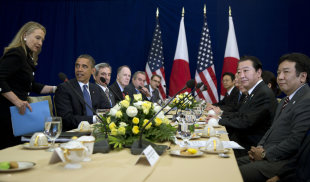KABUL, Afghanistan (AP) — It was Army Sgt. Keith Wells' first Thanksgiving Day away from his family and despite a cornucopia of food provided for the troops, his taste buds were craving his wife's macaroni and cheese back home.
"My wife's a foodie — you know the Food Network, cooking shows. Everything she makes is golden," Wells of Charlotte, N.C., said Thursday at a large international military base in the Afghan capital, Kabul.
The dining hall served up mac-and-cheese along with traditional Thanksgiving Day fixings. Wells was thankful for the good food, but he still missed his wife's home-cooking.
Huge hunks of beef greeted the estimated 2,500 diners as soldiers lined up in the dining hall. Red-white-and-blue decorations filled the room. Brochures titled "Learn about combat stress" served as table centerpieces.
There was roast turkey, sliced turkey, ham and rib-eye steaks. The troops were served steaming side dishes of dressing, corn, collard greens, yams and mashed potatoes and gravy that some lapped up with spoons. For dessert, there was a massive cake with a turkey etched in icing, pumpkin spice cookies and scores of pies.
A short walk from the dining hall, service members were playing a modified version of American football.
Parts of the scene could have come from a snapshot of any U.S. city: American guys in sweats tossing the pigskin, a scoreboard, a coin toss to start the game.
But on this military base, concrete barriers surrounded the field. The referees wore camouflaged shirts and the spectators carried rifles. The artificial turf was frayed and so dusty that when one player spiked the football, a puff of dirt rose from the field.
The players used a regulation football, but the game was a mix of football, soccer and rugby to fit the short field.
Some soldiers commented about the 11-year-old war that has claimed the lives of 2,029 American service members.
Army Chief Warrant Officer 4 Chuck Minton of Monroe, Ga., who has traveled extensively across Afghanistan, was optimistic. "It's been progressing here, getting better. The Afghans have taken over more missions," Minton said.
President Barack Obama pulled 10,000 troops out of Afghanistan in 2011 and 23,000 more this year, leaving about 66,000 American service members still deployed in the country. Nearly all international combat troops are to withdraw by the end of 2014 when Afghan forces will be fully in charge of securing the nation.
Army Maj. Rodney Gehrett of Colorado Springs, Colo., said he was surprised that the war was barely mentioned during the last U.S. presidential election — evidence that some Americans had tuned out the news from the front line a half a world away.
"The war in Afghanistan wasn't even brought up as a topic of conversation" during the election, Gehrett said. "It was a little surprising to me. Hopefully, that will change and people will realize that we still have troops here and they are fighting every day."
Army Sgt. Adam Draughn of Denver, Colo., said some people back home have the impression that the Afghan people don't want American troops in their country.
"Honestly, I think the biggest misconception in my opinion is that, you know, we actually are loved here," Draughn said. "The nationals do care about us. They do want us here to help them. We're not here uninvited."
Most of the holiday chatter, however, was focused on family.
Taking a break from the game, Army Capt. Robert Mikyska of North Aurora, Ill., pulled out a photocopied photo that was taken of he and his wife just before he deployed to Afghanistan nine months ago.
"Hi, honey!" Mikyska said, looking at the picture. "In a couple weeks, I'll be home. I can't wait to be back."
"My family's here," Army Spc. Ricky Clay, also of Monroe, Ga., said as he smiled and embraced his teammates on the sidelines of the football field.











